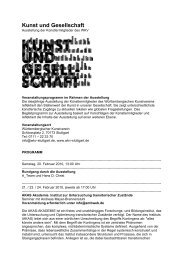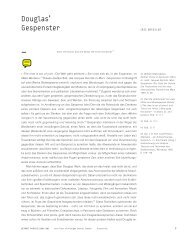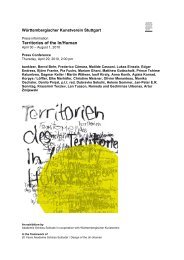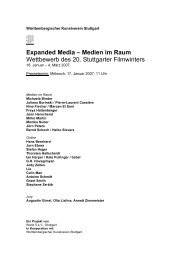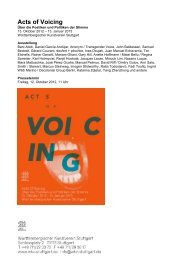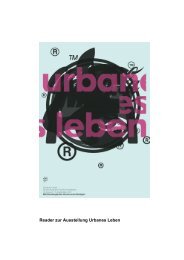English Texts
English Texts
English Texts
Create successful ePaper yourself
Turn your PDF publications into a flip-book with our unique Google optimized e-Paper software.
a discovery that will constantly mark the production<br />
of form in Lygia Clark’s work.<br />
An immediate reading led me to associate this<br />
‘fall’ of Constructivism towards organic form with some<br />
images in F.X. Archive that depict the demolition of<br />
great religious monuments, with a heavy load of stone,<br />
images of destruction with strong symbolic overtones<br />
since their nature as a milestone, once constructed,<br />
now destroyed, is maintained. At first that association<br />
took us to the destroyed image of the monument of<br />
the Sagrado Corazón de Jesús in Antequera, in the<br />
province of Malaga, with its great smashed blocks of<br />
stone scattered on the ground in a diagonal layout,<br />
while to one side lay the main stone plinth. The meaning<br />
was the same, the collapse of a tower, of a little heap<br />
of stones aligned vertically. The fall of the tower, the<br />
fall of the square left a trace in the air, organic lines,<br />
curvilinear traces. The constructivist force of Clark’s<br />
painting, in which the lines were rightly maintained<br />
as straight lines, faithful to the generating principle<br />
of the picture, gave rise to another interpretation. The<br />
destructive gesture was also a constructivist gesture,<br />
the point was not an opposition between the stony<br />
and the organic, it was a conclusion, a constructed,<br />
man-made discovery. And so, reviewing the abundant<br />
iconography of these sacred monuments destroyed<br />
at different moments of iconoclastic violence, we<br />
found in the photo cycle that provides a detailed<br />
illustration of the destruction of the monument in El<br />
Cerro de los Ángeles, in Getafe, Madrid, in the exact<br />
geographical centre of Spain, an image of workers<br />
hauling on a rope tensed by the power of a mechanical<br />
tractor with which they were trying to pull down the<br />
Monument. It was in the tension of the rope that we<br />
found an equivalent to the two aerial lines in Descoberta<br />
da linha orgânica. Little did we imagine the set of<br />
metonymies we were going to make between this<br />
group of photographs and the work by Lygia Clark.<br />
Arquitetura fantástica from some ruins of the<br />
Monument on which a great iron beam transmuted<br />
into an angel’s wing is poised against a drawing of<br />
a starry space, with half-destroyed figures cut out<br />
against the sky, while a soldier, with his rifle on his<br />
shoulder, is watchful. Trepante with the lines of shadows<br />
arranging themselves among the cracks in a great<br />
heap of stones, rocky debris from the destroyed<br />
Monument. Arquiteturas biológicas-estructuras vivas<br />
with a group of workers tied together by ropes, baskets<br />
and loose shirts (the same folds in the shirts and the<br />
carved stone) which bind them to the Monument that<br />
they are about to destroy with levers and drills. Pedra<br />
e ar with the organic image of a heart of Jesus, torn<br />
from among the emblems of the Monument, with some<br />
bullet holes, the crown crushing the representation<br />
of the entrails that are drawn in striations, also aureolas,<br />
also striations of destruction. Máscaras sensoriais,<br />
the face of an angel, detached from the Monument,<br />
whose nose, eyes and mouth have been mutilated,<br />
but which wears a more ecstatic expression precisely<br />
because of that damage. Máscaras abismo, a phallic<br />
shape corresponding to the head of Jesus that crowned<br />
the Monument, whose features have been erased by<br />
gunshots and blows, ‘the stones that have fallen on<br />
it from above and the bullets that have pierced it from<br />
below’, since the militias had used it for target practice.<br />
It is this very image that we have printed on the packets<br />
of condoms, which, at the entrance to Descoberta<br />
da linha orgânica, can be filled with air or helium<br />
and let fly, climbing on high.<br />
It was in the second half of the nineteenth century<br />
that the cult of the sacred heart of Jesus, oddly enough<br />
an attempt by the French to purge Catholicism of<br />
entrails, began to spread across Spain. The local clergy,<br />
especially the Jesuits, were determined to make the<br />
country a safe bastion. The idea of covering the national<br />
territory with these spires, phallic monuments with<br />
a sharp vertical elevation, placed on high ground<br />
and hill tops to the astonishment of Christians and<br />
people in general. The plan, brought into operation<br />
from 1900, consisted of turning Spain into a Monument.<br />
Indeed in many places the metonymy has reached<br />
the word and it is understood that by adoring the<br />
Monument one is in the presence of the sacred heart<br />
of Jesus. The bull’s skin would thus be shot through in<br />
a kind of topological acupuncture that would banish<br />
the evils of a nation of nations in which secularism<br />
and open hostility towards the Catholic Church were<br />
on the increase. The Jesuit militia made great efforts<br />
with these public monuments and crowned the highest<br />
buildings in provincial cities with them, competed<br />
with the factory chimneys where the industrial fabric<br />
was being tentatively woven, adorned the highest<br />
mountains and threw their shadow over the urban<br />
masses of any city.<br />
Symbolically, the consecration in Spain of the sacred<br />
heart of Jesus caused much controversy among<br />
a citizenry in search of self-government, already tired<br />
of the religious and military guardians who seemed<br />
bent on excluding the country from the new myth of<br />
modernity. The events around this hideous sculpture,<br />
its construction, its destruction and later reconstruction,<br />
were what stirred the need to extend the idea of<br />
the Monument throughout Spain over the twentieth<br />
century. The monument business began in 1919 and<br />
immediately became a national cause with the defence<br />
of Christ’s precious vital bodily organ. It was erected<br />
on the so-called Cerro de los Ángeles, a chapel in<br />
Getafe dedicated to the Virgin of the same name,<br />
near Madrid, which was considered the geographical<br />
centre of Spain. The travellers who came to Madrid<br />
from the south could see its silhouette from far off: that<br />
was the intention, to symbolically occupy the magnetic<br />
centre – not in the polar but in the obscurantist sense<br />
– of the nation. A famous photograph of 1936 and the<br />
corresponding film sequence – a firing squad shooting<br />
at the Monument in the style of Goya’s Executions<br />
of 3 May or rather, because of the perspective, of<br />
Manet’s Execution of Emperor Maximilian – bear<br />
witness to the force of the iconoclastic event that led<br />
to the nationalist-Catholic military coup on 18 July of<br />
the same year. The suspicion that it was a theatrical<br />
montage in the service of the anarchist revolutionary<br />
cause has never been dispelled. Indeed the nationalist<br />
variant of the photograph, abused by European<br />
fascist propaganda, was indeed a photomontage in<br />
which the silhouette of Jesus on top of the Monument<br />
crumbled. A crude photomontage, it must be said,<br />
since the cutout of the photograph left its traces by<br />
768 <strong>English</strong> <strong>Texts</strong>



